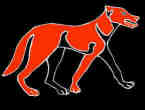This is my last of the excerpts from past issues of Air n-Aithesc that I have to share. I have previously posted excerpts from “Muimme naFiann: Foster-mother of heroes” and ‘“By Force in the Battlefield”: Finding the Irish Female Hero’. The rest of this one can be found in the first issue, Vol 1, Issue 1.
 The next issue should be out at Imbolc, in just a few weeks. I will try to post excerpts in a more timely manner at that point. ~;) Or maybe I’ll even blog something else. ~:p
The next issue should be out at Imbolc, in just a few weeks. I will try to post excerpts in a more timely manner at that point. ~;) Or maybe I’ll even blog something else. ~:p
Going into Wolf-Shape
Humans have lived with dogs for possibly somewhere between 18,800 and 32,100 years, earlier than previously believed.[i]Given highly social nature of both humans and canines and our mutual ability to hunt in groups requiring good communication skills, it seems natural that the relationship would have started when we were hunter-gatherers. Early Neolithic dog burials in Siberia suggest that during this period dogs held an high status not far below humans, beyond their “utilitarian” usefulness.[ii] How natural the relationship is between humans and canines is something most who live with dogs would readily argue, our ability to relate is a given for us. Science has been proving this point, communication and emotional response are strong and similar.[iii]It would be more amazing if humans and wolves—for dogs are wolves who choose to adapt to live in human packs—had not bonded.
There is a great deal of lore and history regarding the importance of dogs among the Gaelic and other Indo-European cultures. Recent genetic testing has revealed that the rose-eared sighthound originated among the Celtic people.[iv] This ancient hound was the ancestor of the modern Greyhound, the Scottish Deerhound, as well as the Galgo Español, which is probably very similar to the ancient hounds. The warrior and the canine are repeatedly linked in Irish lore. One Irish term for wolf, “mac tire” (literally “son of the land”), seems to have first meant a “vagabond warrior” came to primarily mean “wolf.”[v] Many warriors and kings bore “hound” or “wolf” in their names.[vi] The most recognized is Cú Chulainn, who, as a child, took the very role he became named for, “Culainn’s hound,” after killing the smith’s original guard dog in self-defense.[vii] The Fíanna were renowned for their hunting hounds.[viii]
Read the rest by purchasing Air n-Aithesc Vol 1, Issue 1
[i] Elizabeth Pennisi, “Old Dogs Teach a New Lesson About Canine Origins” Science Magazine Vol. 342 no. 6160, November, 15 2013 http://www.sciencemag.org/content/342/6160/785.full
[ii] Robert J. Losey, et al “Burying Dogs in Ancient Cis-Baikal, Siberia: Temporal Trends and Relationships with Human Diet and Subsistence Practices,” PLoS ONE 8(5) 2013 http://www.plosone.org/article/info:doi/10.1371/journal.pone.0063740?
[iii] Gregory Berns, How Dogs Love Us: A Neuroscientist and His Adopted Dog Decode the Canine Brain, New Harvest, 2013
[iv] Heidi G. Parker, Lisa V. Kim, Nathan B. Sutter et al, Genetic Structure of the Purebred Domestic Dog Science, 21 May, 2004: Vol. 304 no. 5674, pg. 1160-1164 https://www.princeton.edu/genomics/kruglyak/publication/PDF/2004_Parker_Genetic.pdf
[v] Kim McCone, “Varia II.” Ériu 36, 1985 pg. pg. 173
[vi] Joseph Falaky Nagy, The Wisdom of the Outlaw: The Boyhood Deeds of Finn in Gaelic Narrative Tradition, Berkeley: University of California Press, 1985, pg. 44, although far more is in this pages notes 19-22 found on 243-245; McCone, “Aided Cheltchair Maic Uthechair pg. 1-30, especially noted on pg. 12-14
[vii]Cecile O’Rahilly, trans., Táin Bó Cúalngefrom Book of Leinster Dublin: Dublin Institute for Advanced Studies, 1967 English http://www.ucc.ie/celt/published/T301035/index.html Irish http://www.ucc.ie/celt/published/G301035/index.html pg. 23-25, 160-163; O’Rahilly, trans. Táin Bó Cúalnge, Recession 1 Dublin: Dublin Institute for Advanced Studies, 1976 English http://www.ucc.ie/celt/published/T301012/index.html Irish http://www.ucc.ie/celt/published/G301012/index.html pg. 17-19,140-142
[viii] J. R. Reinhard and V. E. Hull, “Bran and Sceolang,” Speculum 11, 1936, pg. 42-58, Nagy, The Wisdom of the Outlaw, pg. 44, 95-97
Copyright © 2014 Saigh Kym Lambert